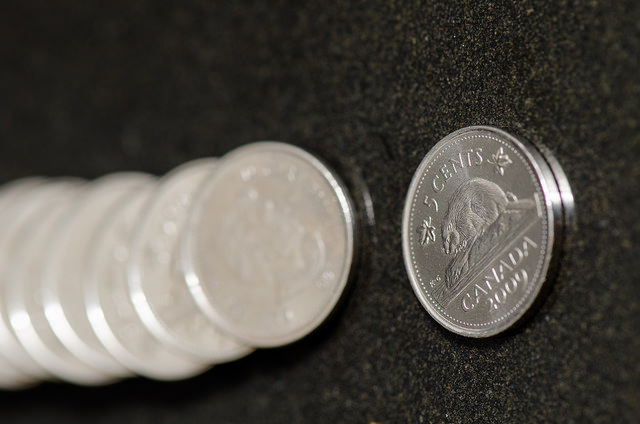Chip in to keep stories like these coming.
With this week’s release of quarterly GDP data, Statistics Canada confirmed that Canada fell into recession in the first half of the year. Canada’s economy (adjusted for inflation) shrank slightly in the spring (for the second quarter in a row), hence meeting economists’ traditional definition of the dreaded “R”-word. It is likely to be short and shallow, a far cry from the global conflagration of 2008-09. But a recession it certainly is. Coming six years into a lacklustre recovery (the weakest since the Second World War), weary Canadians probably question whether the last recession ever really ended.
Not surprisingly, federal Conservatives are scurrying to minimize the political fallout, going as far as redefining the very term. Defence Minister Jason Kenney (adding economic affairs to an already broad portfolio) argues that a “discrete sectoral downturn” doesn’t really count as a recession. Prime Minister Harper claims the downturn is limited to one industry, and that 80 per cent of the economy is “healthy and growing.” (The statistics tell a different story: most of the 20 broad industries tracked by Statistics Canada contracted during the worst months of the downturn.)
The economists’ traditional rule of thumb is admittedly arbitrary, but it has applied for decades, and an election campaign is hardly the time to mess with it. In football, 10 yards is the benchmark for how far you must move the ball for a first down. It’s a totally arbitrary rule. But it’s been used for eons. If a team, having watched its opponent travel 10 yards, tried to change the rule, suggesting that maybe it should move 11 yards for a “true” first down, they’d be laughed out of the stadium. While this recession is obviously a mild (and hopefully short) one compared to others in the past (especially the 2008-09 meltdown), no one should take the Conservatives’ efforts to evade the moniker seriously at all.
Moreover, the Conservatives themselves baked this very definition into their own recent balanced budget law — passed just before the writ was dropped, in a symbolic effort to distance themselves from their own history of deficits. They enshrined the two-quarter rule in actual law, and now they are stuck with it.
Nevertheless, it is certainly true that Canada’s economic problems go much deeper than a quarter-to-quarter drop in GDP, and it would be unfortunate if we now put too much emphasis on that one politically explosive statistic. Canada’s economy was serially disappointing (to use Stephen Poloz’s phrase) long before oil prices tanked last year; that’s the only way that bad news in one sector (oil) could pull the whole country into negative territory. After all, even looking at the Conservatives’ entire tenure (going back to 2006), the Canadian economy has been uniquely and painfully weak.
My recent study for Unifor (with co-author Jordan Brennan) reviewed 16 core economic indicators running from 1946 through 2014 (not even including this year’s miserable numbers). It is clear that the Harper Conservatives’ record is by far the worst of any postwar prime minister who served more than a year in office. The full report (including 26 pages of mind-numbing historical data, fully sourced) is available here. Now that the recession has been confirmed, I hope the election campaign now starts to address some of these deeper challenges:
Investment: For years Canada relied on energy megaprojects to lead business investment. But that engine is now sputtering badly, for the foreseeable future. Expensive corporate tax cuts didn’t produce any measurable uptick in investment. We need new strategies to elicit badly needed capital spending — both private and public.
Exports: This government’s trade strategy consists almost exclusively of signing lots of free trade deals. They’ve inked six, and are negotiating several more (including the Trans-Pacific Partnership, which might be concluded before Canadians go to the polls). Yet Canada’s actual exports hardly grew at all under Conservative rule — by far the worst record in post-war history. It turns out that producing valuable goods and services that foreigners actually want to buy, is a lot more complicated than signing trade deals and waving them about.
Productivity: Free markets and low taxes are supposed to automatically spur efficiency. But Canada’s measured productivity performance has been abysmal: growing less than 1 per cent per year, badly lagging previous governments and most of our trading partners. Upgrading, innovation, and investment are the prerequisites for productivity — yet we’ve gone backward in every area.
These are more profound and important economic challenges than the momentary ups and downs of the GDP cycle. They explain why the Conservatives’ brand as “capable economic managers” has been so tarnished — and not just by this year’s lousy numbers. In a longer-term view, the Harper government has presided over the weakest economic era in Canadian post-war history. That’s not entirely the government’s fault. But enough of the damage was self-inflicted to cast major doubt on its economic credibility.
With the GDP numbers under our belt, let’s hope the election debate now turns to more important policy questions. Let’s talk about the fundamental drivers of Canadian economic progress: working more (and working more productively); investing in people, innovation, and capital (private and public); producing a full portfolio of excellent goods and services we can sell to the rest of the world. And let’s see which party offers the most convincing set of proposals for reversing Canada’s increasingly glaring failures in every one of these areas.
Jim Stanford is an economist with Unifor. A version of this commentary was originally published in The Globe and Mail.
Photo: KMR Photography/flickr
Chip in to keep stories like these coming.



